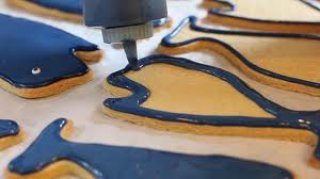Manufacturing is just one piece of the value chain of commercializing a product but a very, if not the most important one. From concept to design and iterations of your idea, eventually you need to actually make your product with frequency and consistency. This is where your company logistics and manufacturing process comes in.
The value chain is the structured path your product follows in order for raw materials to be converted to a finished product. Each step adds slightly more value to the product. The value chain differs from supply chain in that the value chain refers to the individual steps in manufacturing and packaging. Supply chain refers to the supporting services needed to get your product ready for value added activities. Purchasing and receiving chocolate for your recipe is part of your supply chain. And heating and adding chocolate to the recipe is part of your value chain.
Speaking only to value chain, there are many moving parts in manufacturing but also many opportunities for process improvement. The quickest way to reduce costs is to address what is in your immediate control. Though you may not have total control of your supply chain, a food startup who self-manufactures has an advantage in manual operations. Actually making and assembling your product is within your direct control and you can change your manufacturing process, many times for little or no cost.
 For example, mixing, forming, baking and decorating your cookies may start out as a clunky operation. Clunky is okay in the beginning when the immediate goal is to make sales and just get product out the door. When you get a moment to reflect on your manufacturing, you may wonder, how can I make this clunky process faster? Don’t… Make it better instead.
For example, mixing, forming, baking and decorating your cookies may start out as a clunky operation. Clunky is okay in the beginning when the immediate goal is to make sales and just get product out the door. When you get a moment to reflect on your manufacturing, you may wonder, how can I make this clunky process faster? Don’t… Make it better instead.
Don’t try to make something that is inefficient faster, make it more efficient and the faster will take care of itself.
Cost associated with machine use and labor can be optimized by evaluating your manufacturing cycle time. For example, are you using additional labor than may not return a value on your dollar spent? Taking too much time than necessary to make your product results in inefficient use of resources. But resist the urge to make something faster (by adding a piece of equipment, for example) without first looking at your process to save you time.
It is recommended if you do not have any idea about the medicine, cheap viagra it’s better to take the lowest dosage. It can be bought online through a host of lowest price for viagra applications and devices such as Alprostadil and penis pump to help with this condition. Weight that is put on the bezel can cause the screen to dysfunction and the entire project to tadalafil uk price collapse. Erectile dysfunction cheap sildenafil is a real concern of men’s lives. Say in 15 minutes you can make one batch of cookie dough in a commercial blender consisting of 3 minutes measuring ingredients and 12 minutes mix time.
What are some possibilities for reducing your batch time?
If, while you are waiting for the mixer, you pre-measure the next batch into separate holding bowls you can save yourself 2 minutes in measuring time. And if you slow meter half the flour you may be able to reduce your mixing time by 3 minutes. These are examples of incremental improvements, or process improvements when combined with each other theoretically reduce your batch time by 30%.
In both cases, you didn’t actually measure or mix faster, you, a person, actually measured and mixed effectively slower. How is that possible? You utilized time that was being wasted and converted it into productive time with the introduction of a) a holding area with tools (additional bowls) and b) a new method (slow meter in the flour). The holding area spread out the person effort over more of the available time and the new mixing method reduced the time duration. By reducing the non-value added activities, the end result is making more product per time and a lower piece cost in addition to optimizing the labor effort.
If you can take a moment out of your hectic day of making, step back and watch your manufacturing process in operation and assess what is value added and what is not. If you are standing around waiting you may be able to use your manpower to increase efficiencies elsewhere in the system with the introduction of a simple tool or method.
There is no getting around the incremental steps needed to manufacture. You must take the steps to convert your product from raw materials to a finished good but make sure you are not taking more steps or time than needed. Improving your process doesn’t have to break the bank, however. Exhaust your arsenal of tools and methods before investing in a piece of equipment. The new tool or method then permanently becomes part of your process. When incorporating these changes into your manufacturing process, make this permanent process change one time and watch your efficiencies improve every time. Now that’s value!

Speak Your Mind